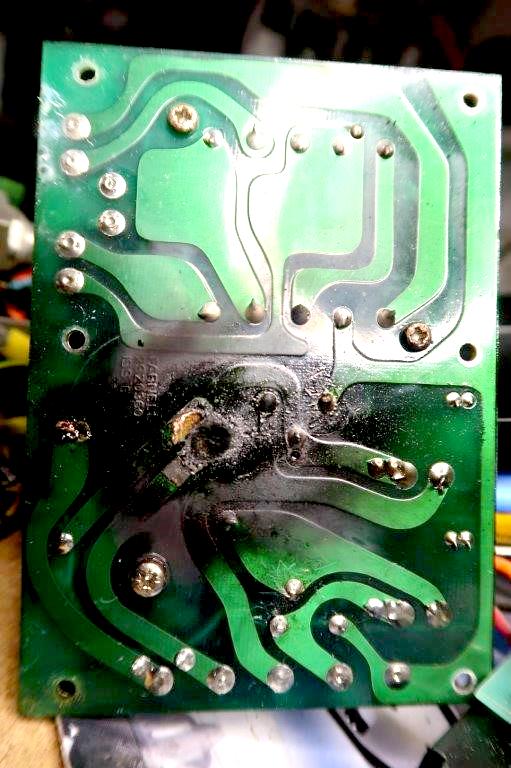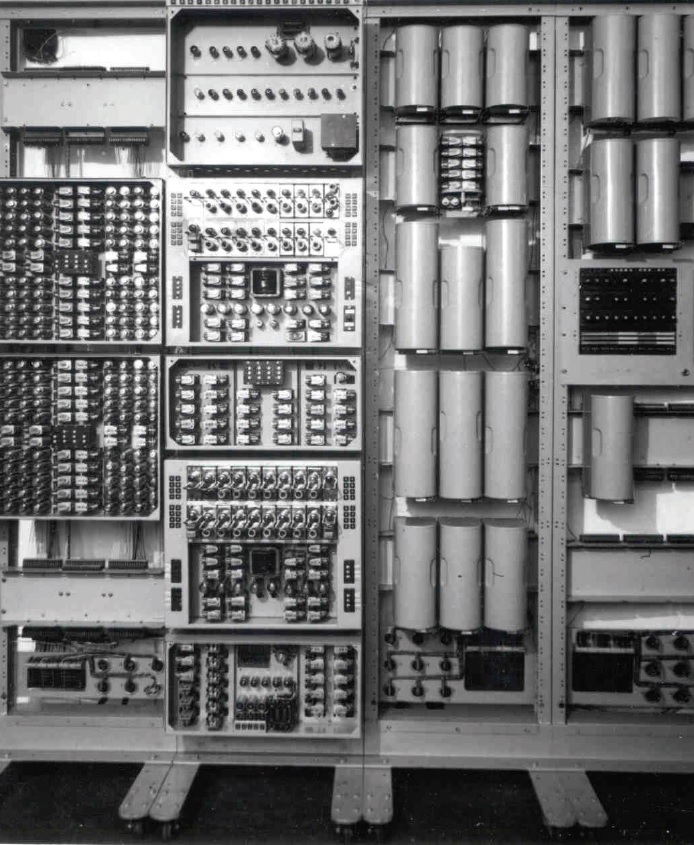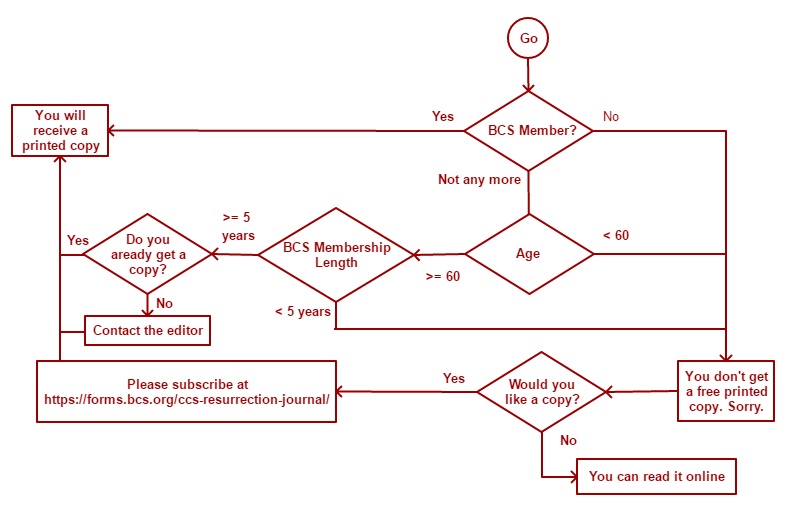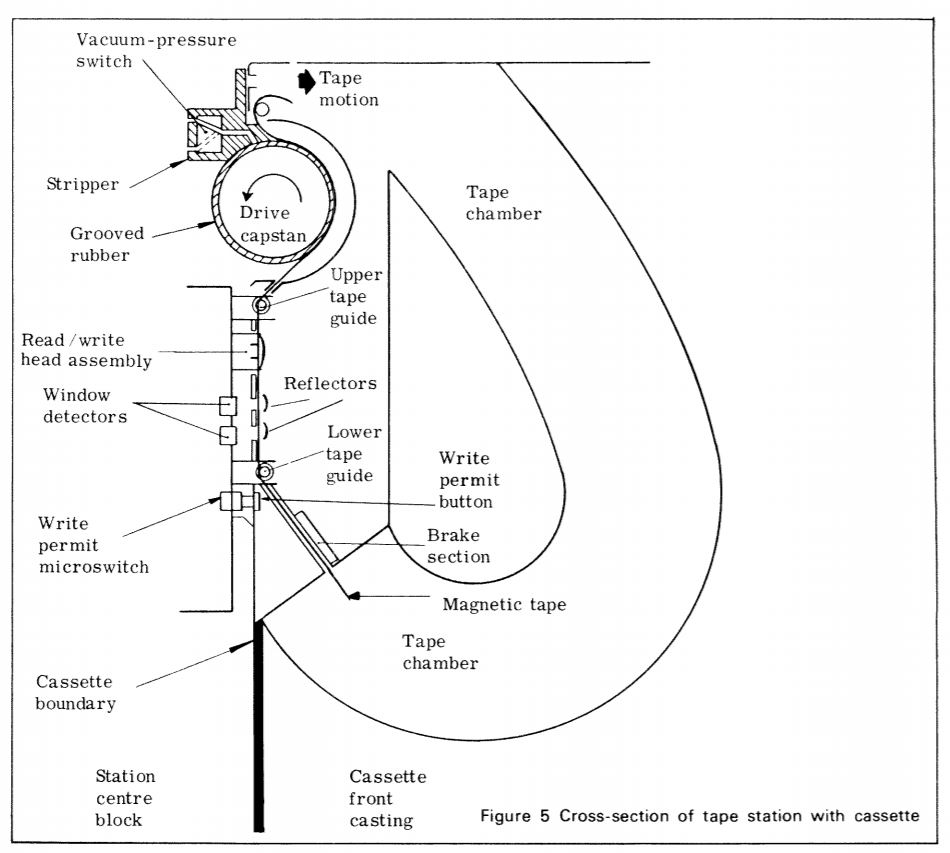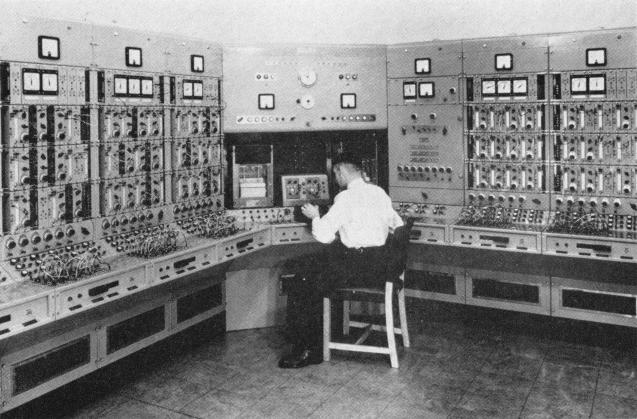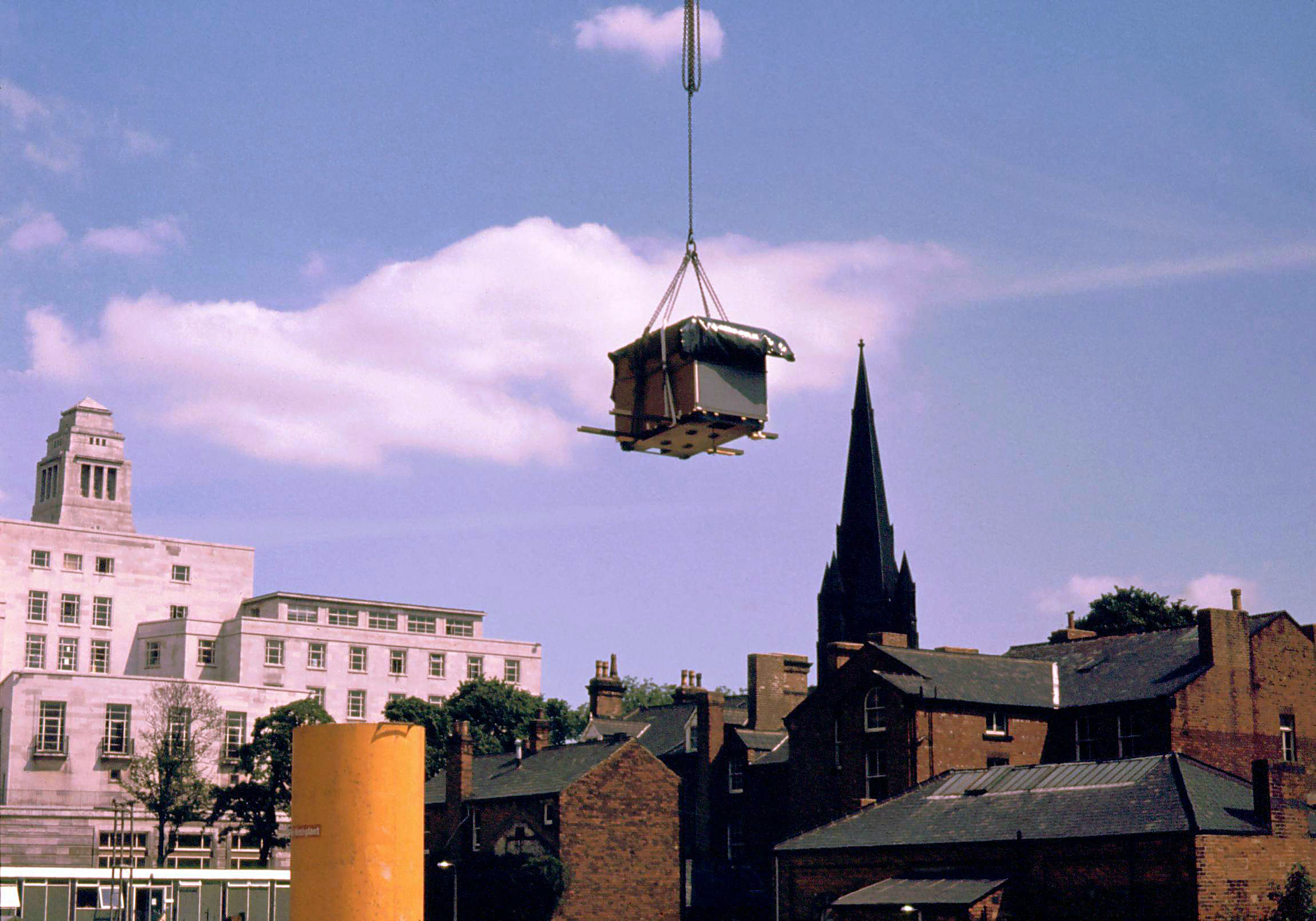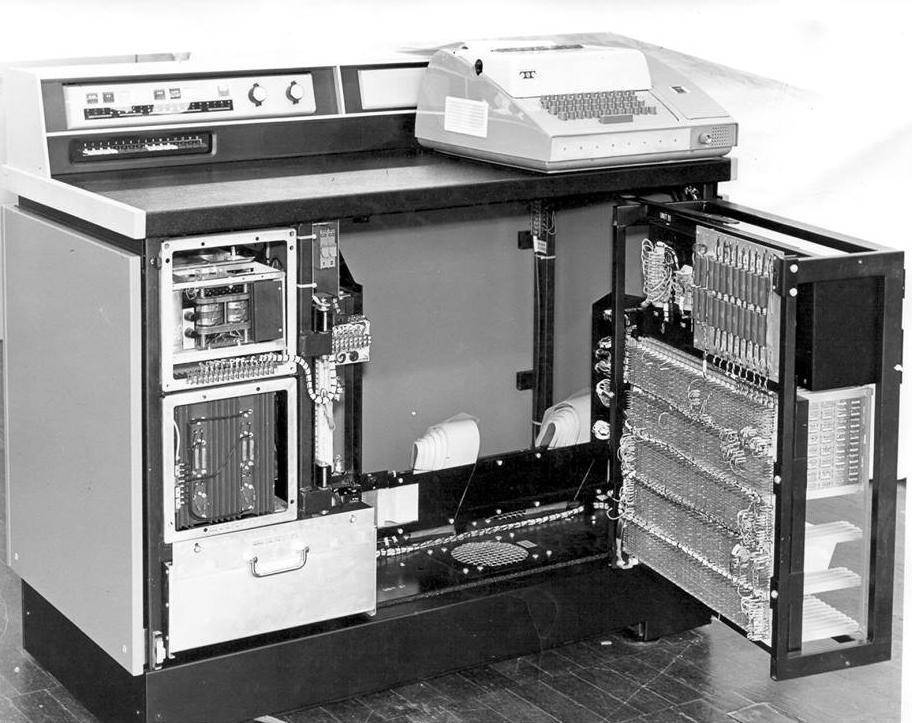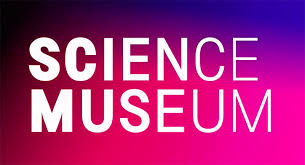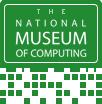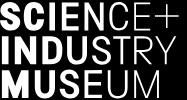| Resurrection Home | Previous issue | Next issue | View Original Cover | PDF Version |
Computer
RESURRECTION
The Journal of the Computer Conservation Society
ISSN 0958-7403
|
Number 94 |
Summer 2021 |
Contents
| Society Activity | |
| Queries and Notes | |
| Bryant Discs Revisited | Varos Shahbazian, David Holdsworth, John Harper |
| Archives of IT: Discover, Learn, Share Industry Insight | Tom Abram |
| Book Review: So to Speak: Stephenie Shirley | Peta Walmisley |
| ICL’s PF56 General Purpose Controllers | David Wilcox |
| Review Conversations with Frank Land | Martin Campbell-Kelly |
| 50 Years Ago .... From the Pages of Computer Weekly | Brian Aldous |
| Forthcoming Events | |
| Committee of the Society | |
| Aims and Objectives |
Society Activity
|
Elliott 803, 903 & 920M — Terry Froggatt As we come out of lockdown, Peter Williamson reports that the TNMoC 903 is working, although the power relays for the extra store are slow to come on. I’ve seen this problem before and I think it will sort itself out with more regular use. Hopefully we will soon reconnect the engineering display panel. The hinge stop on the paper tape punch has broken: Peter intends to repair it. Andrew Herbert adds that the paper tape reader tension might also be in need of adjustment. Peter Onion tells me that the TNMoC 803 is currently “dead”: one day back in October it failed to turn on, and he has only just now able to start visiting the museum to fault find. He found that the +10V supply was failing to come on when the COMPUTER ON button is pressed, but after a couple of days working on it at the museum, he was no nearer finding the cause. So he has taken the +10V TS1 board home, where he has it working on the bench, although the regulation doesn’t seem very good. His next step will be to add supplies for the other voltages, computer on and off switches, and a “hold on loop” relay, so that he can test the on/off circuitry as well. He notes that there are some spare TS1s of unknown status in the TNMoC boiler room stock of boards. Neither the RAA/TNMoC 920M, nor the eBay 920M here, are currently working. We suspect problems with their “power good” signals, processed by module G52. There is only one such module in each 920M, and we are reluctant to risk shipping the possibly unique working module from Erik Baigar’s spare 920M in Munich, given the problems with post-Brexit customs paperwork. However, the folk at RAA (Rochester Avionic Archives) did offer Andrew Herbert any spare modules he might need, which may be a better route to follow, now that they too have access to their building again. Meanwhile, I have made some progress in understanding the wiring of the eBay 920M at home (even though it is not working), and I’ve found at least one surprise. On the TNMoC 903, there is a row of 18 “Number Generator” keys. Most of these ground their wire to the CPU in the ‘0’ position, but a handful ground it in the ‘1’ position and the CPU inverts these signals. The effect of this is, that if the 903 is used in an embedded application with no control panel, the inputs will all float high, and the Number Generator will appear as a Jump to 8177 instruction, which will start the application program that is already in core store. And to update the program, a “program loading unit” can be attached in lieu of the normal paper tape station, which grounds the address pin worth +4, giving Jump to 8181, which will neatly invoke initial instructions. The surprise is that on these 920Ms, this handful of Number Generator keys is NOT inverted in the CPU: all 18 key inputs are the same way up. (There are other signals into these 920Ms, which are grounded by the control panel, and which float high when it is not present, and they do pull the handful of key inputs low, so the correct “Jump” instructions are still generated). We know that the 903 and 920B control panels are physically and electrically identical (except for the name written on them), and my memory is that the 920M control panel which we used when developing the Jaguar flight program was also the same, certainly physically, and we never had to remember that “some keys are upside down”. I worked on the MCM2 & MCM5 variants of the 920M in the 1970s, whereas the RAA and eBay 920Ms are MCM7s from the 1980s. So it does look as though the control panel and the interface to it were changed between 920M variants. No doubt there will be more surprising changes. Erik has posted a video about the 920M at www.youtube.com/watch?v=v-gF5g0nnoE. |
|
IBM Museum — Peter Short The Hursley site remains closed. Meanwhile the curators are scoping potential projects to devise a way to gather more information about our visitors, their interest in the museum itself and ultimately how we can improve their experience. Of particular interest is how our younger visitors interact with the museum and its exhibits, and how we may be able to help stimulate interest in Science, Technology, Engineering and Mathematics (STEM) for upcoming generations. Work also continues on sorting and making available online hundreds of photos and documents by machine type. |
|
SSEM — Chris Burton While the Science and Industry Museum in Manchester was still closed, a start was been made in preparing for the initial switch-on of the SSEM ‘Baby’ this summer. Discussions among the volunteers resulted in a consensus regarding removal of accumulated dust, inspections for untoward damage for example rodent attack, and a decision to use the standard switch on procedure augmented with extra careful observation of any anomalies and immediate shutdown for later analysis and repair. Appropriate risk assessments have been put in place by curatorial staff to protect all of volunteers, the machine and SIM staff. |
|
ICT/ICL 1900 — Delwyn Holroyd, Brian Spoor, Bill Gallagher, David Wilcox ICL1904S Emulator Brian has been looking into the 1900 overlay mechanism, prompted by trying to reverse engineer an overlaid program and finding unexplained things in the program layout and core image. This investigation is uncovering things not covered in the various manuals we have, in some cases features that are implied to not exist or are ‘just invalid’. From the information that we have, there appear to have been three distinct generations of overlay packages/loaders, with additional ‘invisible’ support for overlaying in the consolidators (linkers in modern terms). We are lucky to have examples of all three generations of overlay packages. Further work is needed, at the end of which a short paper is planned; if for nothing else, just to remind ourselves of those changes and hidden facilities. PF56 Emulator Inroads into further understanding of the EDS200 disc interface/application module have been made very largely by David. The details of the control registers and bit assignments are becoming clear and the EZDE DCP has been able to read the disc. The loading of OLTs hopefully will follow. We are still looking for any further information regarding the communications protocols CO[0123]. Currently we have a very sparse collection of relevant documents — just what is in Data Communications & Interrogation and gleaned from exec listings, nothing at all on CO2 or CO3. As usual, we are prepared to cover reasonable photocopying/postage costs and to return any documents (if requested) after copying and scanning for future preservation. |
|
ICL 2966 — Delwyn Holroyd During the closure period the system has been run up several times to check for any problems — I’m happy to report that no new ones have been found. For some time we have experienced occasional disc failures in George, with which no doubt many readers will be familiar. The unusual thing in this case is that the discs are emulated, so failures are definitely not expected! When this has happened in the past, the expedient solution has been to reload the system which has always cured the problem. However when the problem occurred during one of the check-out sessions I decided to investigate further. The first thing of note was all three emulated discs appeared to go offline at once, making George extremely unhappy and causing a very unpleasant shriek from the speaker on the OCP! On connecting into the disc emulator I found the control program apparently hung and unresponsive to input. I killed the process and restarted it, but the same thing happened again. Next I enabled command logging to see what was going on — this facility outputs each tag command received from the 2966 and the response. I was surprised to see that the emulator was receiving a flood of commands, so rapid that it couldn’t keep up, explaining the lack of response. The commands consisted of selects and seeks to tracks 0 and 1 alternately on all three emulated discs, but without waiting for the previous seek request to complete! No attempt was being made to actually read any data. The disc emulator isn’t designed to cope with receiving a seek whilst another is in progress, and indeed I’m not sure how the real CDC disc hardware would react to this kind of abuse — who knows what cylinder the heads would actually end up on? What isn’t clear is exactly how it ended up in this state — it’s possible that the emulator did something to upset the 2966 disc controller which resulted in this strange state, or it could just be a straightforward intermittent disc controller fault. After reloading I kept command logging switched on in the hope the problem might re-occur, but of course it didn’t! I’ll continue to run with command logging though in the hope of catching the moment of failure. In my last report I described the work being done to build a new 2966 board tester — I’ve now received the part-assembled board from China, fitted all the remaining through hole components (mainly connectors and jumper headers) and successfully commissioned the setup. |
CCS Website InformationThe Society has its own website, which is located at www.computerconservationsociety.org. It contains news items, details of forthcoming events, and also electronic copies of all past issues of Resurrection, in both HTML and PDF formats, which can be downloaded for printing. At www.computerconservationsociety.org/software/software-index.htm, can be found emulators for historic machines together with associated software and related documents all of which may be downloaded. |
|
Harwell Decatron (WITCH) — Delwyn Holroyd
It has been some time since I last reported on the WITCH. The museum has been closed to the public for most of this time, and travel restrictions prevented me from visiting until April. The machine has been regularly run up during this period by local museum staff and volunteers who were able to be present on site. In addition, since April the WITCH engineering team has conducted various checks and tests with no real problems to report. April 2021 marked the 70th anniversary of the machine first being made to work, albeit with only two stores. The picture shows the machine in this early state. It wasn’t until May 1952 that it was handed over to the theoretical physics division at Harwell. |
|
Turing Bombe — John Harper The machine has been kept in good order with maintenance. Only minor repairs have taken place. We are aiming to provide public demonstrations on all days except Mondays; the same programme as before the shutdown. In my last report, I mentioned that we have installed a temperature and humidity logger. This has provided us with a full log of data and although there were a few instances of rapid change, none of these were beyond the set limits so nothing that concerns us. Drunken Drive demonstrator project is now up and running with parts made or being made. This mechanism is one assembly of which there are 36 fitted on the four-wheel Bombe version called the High Speed Keen. I have been aware for some time that we demonstrate a three-wheel machine which could lead to visitors believing that this was the only version of the Bombe available in WWII. In fact, there were over sixty, four-wheel Bombes. Their major contribution was to tackle the Atlantic U-Boat menace that almost brought the UK to starvation. It is not realistic to expect that we could construct a full High Speed Keen, but we can produce examples and display interesting mechanisms starting with the Drunken Drive demonstrator. |
|
IBM 360/20 Project — Adam Bradley Firstly, on behalf of the team, I would like to formally thank the CCS committee for accepting our project into the ranks, particularly given some of the complications surrounding the framework of entry. The support of the committee is greatly appreciated, and we look forward to working with the CCS moving forwards. The IBM 360/20 project history is available on our website (www.ibms360.co.uk), and we would invite anybody who hasn’t read the story of how we acquired our machines to do so at their leisure. As this is the first report, I thought it may be pertinent to provide an overview of the machines we have in our collection:
Timeline Below is an overview of the current project milestone and when they occurred:
The Team
Current Project Status Since arriving in the UK the systems have undergone an initial round of cleaning to remove the 35 years of dirt that had gathered on them in their original location. The project progress has been stalled somewhat by the COVID-19 pandemic, and further by construction works occurring in the building where the machines are currently housed. We are hoping that these construction works will be completed by mid to late summer of this year, which will enable us to properly lay out the primary machine in the correct format with the cables run under the flooring. We will then begin work on the power supply units. We are hoping to find somebody with experience of working on large, three-Phase, linear power supplies such as the one contained within the main CPU. This person would need to be able to travel to Aylesbury as the PSU is not removable from the cabinet. We would also like to re-cap the entire machine as the existing capacitors are nearly 60 years old, and likely contain polychlorinated biphenyl. Media Coverage We received significant media coverage during 2019 and the early part of 2020 with multiple articles across several tech news sites including The Register, a large crowd funding campaign, several podcasts, and exposure in the BBC documentary “Silicon Glen”. This has led to the IBM 360 blog site receiving nearly 20,000,000 unique impressions since its inception. Funding The project is currently entirely funded by the team, with the only external funding having been received from the initial crowd funding campaign to raise the money for transporting the machine to the UK. The funds from that campaign have been long exhausted, and thus all ongoing costs are being paid for by the team themselves for the time being. |
|
Software — David Holdsworth Elliott Algol Andrew Herbert is now looking at how to present the original Elliott source code, along the lines already used for LeoIII and KDF9 code. KDF9 Emulation Bill Findlay has released a new version of ee9 which is to be found at: www.findlayw.plus.com/KDF9/emulation/emulator.html. We have made initial moves towards getting the NPL version of the KDF9 director into a working state. You may recall that we have a version copy-typed but without having been adequately proof-read. However, I used to be very familiar with this software and hope to be able to get it working again. CSIRAC Emulator Bill Purvis has developed an emulator for CSIRAC the oldest stored-program computer in existence. CSIRAC was developed in Australia and first worked in 1949 and so was probably the fifth such machine in the world. The emulator and much other useful information about CSIRAC is at www.computerconservationsociety.org/software/csirac/base.htm. |
|
Queries and Notes
|
A new semi-regular feature in which questions which come our way are discussed and (sometimes) resolved. Reel-less Magnetic Cassette Tape Cartridge System We received an enquiry about a reel-less Magnetic Cassette Tape Cartridge system used on an ICL machine during the ’60s/’70s. “The unknown type of ICL machine in question had large (600mm × 300mm or bigger) cassette data storage tapes. They were reel-less. The three inch tape was simply spewed from one end to the other and it just fan folded. Presumably the tape was driven through the centre by rotating rollers in each direction.” Immediate Response from Brian Spoor -
Sounds very much like the ICT 2501 Cassette Tape System, originally designed for use with the 1901/1902/1903 processors, also available with the later 1901A/1902A machines. Reading the manual makes me shudder, but they were designed as a ‘cheap’ option for use with the low end processors. For more information see — Cassette Tape Manual — www.icl1900.co.uk/techpub/tp4092.pdf User Notices — www.icl1900.co.uk/techpub/tp4092-un.pdf Further Thoughts [Ed] It seems that the tape was a continuous loop. One track (of eight) was accessed at any given time. When the join was encountered, the action was moved to the next track until all eight had been used. In principle this seems much the same as the notorious 8-track audio tape players which came and went in the 1970s though in that case the cartridges were much smaller and the tape was wound onto a central core. During operation the tape emerged from the centre of the coil and was returned to the outside. In that system only one (mono) or two (stereo) read heads were fitted which were physically moved between tracks. Similar but smaller still was the much later Sinclair Microdrive tape system of which many thousands were sold by ICL in their One-Per-Desk machines. They were famously unreliable. Another oddity was the quarter inch cartridge system (QICtape) although it did not employ a continuous tape. Only one track was active at any one time and when the tape arrived at one end, it simply reversed and changed track (“serpentine recording”). Again, ICL offered this system with low-end Series 39 computers largely as an inexpensive means of software delivery in machines which would not otherwise have needed “proper” tape systems. Few, if any, seem to have been sold — I certainly never saw one. ICL 1900 Assemblers In return Brian Spoor asks — “We have been examining various items of 1900 standard software to understand how they function. Some have raised a question about in which language they were written. We currently have, in addition to the usual various high level language compilers: —
It is obvious that some software programs have been written in an assembler, the binary structure allows for nothing else. Others have been written using a compiler, their binary structure matches that of normal consolidated programs. This query concerns compiled programs/subroutines, of which most can be identified as being written in either PLAN or Plasyd (code sequences generated). We have recently found some routines that show some signs of Plasyd (or higher level language) constructs, but not the usual Plasyd code structures, which makes Plasyd extremely unlikely. These code structures are very unlikely to be written directly by a PLAN programmer, but are possibly generated by macros. However, there are some things in those structures that cannot be generated by a PLAN compiler — they are using features that, according to the manual, are not available. This gives rise to our suspicions that there was another language/compiler used internally by ICL, possibly PLAN-like but with additional features/structured coding facilities, but not as high level as Plasyd.” Can anybody help brian@fcs.eu.com please? Mystery Photo A member of the public sent us this photo of his late father seated at some sort of computer.
We were asked to identify the computer. In less than three hours, Bob Geatrell, using his formidable web searching skills, identified it as an Elliott ND411 — an analogue computer, in this case simulating the operation of nuclear power stations as described by Simon Lavington in his Elliott book with the same photo. |
Bryant Discs RevisitedVaros Shahbazian, David Holdsworth, John HarperJohn Harper’s description of his experiences with Bryant discs has provoked much correspondence. Varos Shahbazian wrote — At the Eastern Gas Board we had four of the later model attached to three 1904S Stars. As I recall, we used isopropyl alcohol to clean oxide from magnetic tape heads, but it wasn’t used on the discs, since in theory, nothing was allowed to touch them. Alas, all too often the heads did. In an attempt to prevent this, the paddle technique, as described, was used to coat the surface with wax emulsion. It was, by modern standards, a fraught business. You had to expose the discs, start the disc motor, then turn it off and, while the discs were still spinning, move the wetted pad in and out from hub to periphery for each disc. I used to do this (on my own) every Sunday night ready for Monday’s work. Nevertheless, touch-downs still happened all too frequently and could be detected by opening the cabinet a fraction and sniffing. Later crash detectors were introduced, but since these had trailing tubes across the floor, the operators frequently trod on them resulting in a false alarm. Crashed discs were made into coffee tables, but there came a time of shortage and they were requested back — legs and all! The hydraulic oil, at 1000 psi, could leak and cover the underfloor void. It smelt of marzipan. The drive belts would stretch and then one would perch on top of the cabinet to remove a link, since they were formed of a series of links. All in all, John’s account reminded me of many happy memories of these beasts! David Holdsworth joins in — When the Bryant disc messages appeared a while ago, I stayed mum as I could not remember the type number of the disc that we had on our 1906A. However the picture in Resurrection 93 looks very much to be the same thing. Ours was a disaster, and was craned out in desperation, as shown in the picture: Do any others remember Bryant monster discs on ICL1900? Ours shook the building, and suffered head crashes on occasion. It was moved out in favour of EDS30s. I have strong recollections of a giant crane being needed to remove the disc from an inconveniently located machine room. Does the packaging look familiar to anyone?
John Harper replies — The Bryant disc on which I reported was basically the same as that on 1900 except with different interface hardware. I do believe that the 1900 versions often had more active discs/capacity than we had. There were quite a few Bryant discs connected to 1900s. We and other 1500 maintenance staff kept hearing about major breakdowns on 1900 installations. We were not called in for a major investigation to find out how our machine gave virtually no problems against those attached to 1900s. You mention severe vibration, this may have been bearing failure or damage to one of the discs. If one of these discs broke up it would be more like an explosion with so much weight spinning at such a high speed. Not something to contemplate in a computer room! When you say “replaced by EDS30s”, was this just a reliability issue, or was it partly to do with having an exchangeability advantage? And back to David — Herewith my hypotheses about the different experiences with the giant Bryant fixed disc. I know that we had one or two head crashes, which could have been due to less clearance needed in order to increase recording density. The cause of the vibration was head movement. All the heads moved in unison, and there were a lot of them. My hunch is that the disc allocation strategies of the 1500 were very different from those of George3. I do not think that there was much in the George3 disc allocation designed to keep down head movement. I remember rewriting part of the backing store allocator, and it eventually got incorporated into the official ICL release as ABSA (Alternative Backing Store Allocator). The switch to EDS30s was just in search of reliability, and we lived with the reduced capacity. We had had good experience of the two fixed discs on our KDF9 that preceded the 1906A. We think our KDF9 was the only one with two discs. I would be interested to learn of any others. And finally from John — You say vibration. If it were vibration I would read this as a continuous motion. However, the track selection was extremely erratic with small lurches between track selection and quite violent movements when there were many tracks to cross. If the latter then this is what one might expect but to me, vibration is a constant activity that could be brought about by some form of imbalance. If so, I would have expected the operators to close all programs smartly. When power is removed all the heads were retracted hydraulically but it took several minutes for the discs to come to a stop. Until it was running slowly the covers were locked. [ed] never saw a Bryant disc unit, but there was a legend that the one attached to the 1906A at Oxford University slowly walked across the machine room floor leaving a deep gouge in its wake. This may or may not have been true. Let’s hope it was. |
Archives of IT: Discover, Learn, Share Industry Insight
Tom Abram
Archives of IT (AIT) is a registered charity capturing, analysing and sharing the oral history of the IT industry in post-WW2 UK. Our aims are to promote public understanding of the achievements and importance of UK tech and ensure that young people are aware of and aspire to fulfilling professional careers in our industry. We focus on the people who created and developed the industry and complement organisations that preserve and inform about technology and devices. We believe that this is not just an important part of the UK’s industrial heritage but is also a fascinating story that will engage and inspire. The Purpose of AIT “The Archives of IT” may sound like the complete history of technology in the modern world but we are a bit more focused than that! We collect and protect, study and share oral history and documents that tell the story of the UK industry through the words of the people who made and are making it. AIT complements and aspires to work with those other excellent collections that restore, preserve and present devices and technology. As of May 2021, we have completed over 160 interviews of leaders of the industry, its customers, observers and influencers, recording their lives careers, experiences and opinions. Our interviews and analysis thereof provide insights from leading players in “Tech”, or “Digital” as some like to call it, into what drives people to have great ideas and how they leverage them through organisations and products that change the lives of billions of people around the world. We are not content to just keep these facts, stories, and lessons safe, for researchers and enthusiasts to access occasionally (although that is one of our purposes); we work at engaging with the public, especially young people, to ensure that this great success story becomes part of society’s historical general knowledge. We encourage academics and researchers to study the sociology and economics of IT people and firms and its impact on UK society. Putting the record straight Writing this article for the magazine of the Computer Conservation Society feels a bit like preaching to the converted but maybe it is worth explaining why we are doing this. AIT was founded in 2015 by Roger Graham OBE, himself a pioneer of commercial computing, having developed BIS Group Limited in the 1970s and 80s and subsequently been involved in multiple start-ups. Roger modestly claims that it was not his idea, but he has driven it forward and supported it, only now stepping back a pace to let a new Chairman, John Carrington, and an expanded board of trustees take the baton. A key motivator was the belief, perhaps not widely understood amongst the general public, that this is a British success story, that it is unique in several ways and deserves to be told. Firstly, as the UK computer fraternity is well aware, we stake a claim to the world’s first stored program computer and the first Turing machine. The only matters in dispute are whether those are one the same thing and in which city of the UK they happened. There is a widespread impression amongst the public that computers came from the USA, labelled IBM and Microsoft. Secondly, we would argue that this industry has had an unparalleled effect on our economy and society, largely to the benefit of us all. Just counting the people who make and program computers — the IT Industry — it amounts to around 2.5 million employees. No other enterprise has had this scale or grown so quickly: from a handful of experimental machines to ubiquity in 70 years. Even coalmining at its peak only employed around one million and it took a while to have an industrial impact. Furthermore, most people in other industries use this technology at work and almost everyone uses it at home or in their personal lives. Again, public misconceptions are rife: “the device in my pocket is a phone, not a computer”; “teenagers would rather work for Google than in IT”; “IT is not creative or caring”. An engaging and inspiring story So, our focus is people, how they have created this unique industry and the effect that is has on other people. The story has the same human interest as pioneering stories such as the Brunels’ ships, bridges and tunnels, Stevenson and his Rocket, Whittle and his jet engine. It engages people in the same way as other elements of social and industrial history. A key aim of AIT is to present this in terms that draw in the non-specialist. For example, we highlight not just that Cyril Hilsum’s pioneering physics enabled the Liquid Crystal Displays that most of our portable devices used for the last 50 years, but that he beat Alan Turing at chess when they were both working at the National Physical Laboratory. Norman Sanders became an unwitting architect of UK industrial policy when he happened to meet Harold Wilson in the USA, energising the While Heat of Technology revolution and the creation of a national IT industry. All our interviewees are asked to reflect upon lessons learned, successes, failures, and mistakes and the answers are not always what you might expect. Tom Ilube, one of our most respected and successful entrepreneurs said, “I’ve failed constantly. What I’ve learnt over the years is that almost every time you fail, if you do keep going, something else comes up.”, while Steve Furber, who architected the world-beating ARM chip, cryptically says his biggest mistake was “BBC Micro disc error 14”. Alderman and Sherriff Professor Michael Mainelli takes a different tack, “My biggest thing is never to have had a plan for most of my personal life. I’ve always done things sort of backwards”. You don’t have to be a computing enthusiast to learn something from each interview! A fertile area for study There are hidden insights in the Archives waiting to be uncovered by researchers. A key feature is the discussion of social origins: parents’ and grandparents’ education, occupation, geographical and other background. Having collected 160 interviews, we have now just started to pore over this data and are considering whether, for example, family prosperity, parents’ attitudes to education, studying Arts vs. STEM have influenced people’s direction and achievements. If you visit our website, you will find the first thinking on this. It is probably no surprise that Colin Knight became a multiple achiever in business and philanthropy, having been brought up by “workaholic” father and mother, albeit in food retail rather than technology. Professor Kevin Warwick’s grandfather suffered from Parkinson’s Disease and Kevin became the first person to embed an electronic device in the human body on the road to interfacing AI with the central nervous system. Other work that has made us think about ambition and drivers for achievement. Matthew Parris’s book Fracture asserts that many great lives take root in trauma; or the school of hard knocks as it is used to be known. Did Dame Steve Shirley’s Kindertransport experience spur her on to great things? There are clues in her words quoted on the AIT website. Many of our interviewees were evacuated in WW2 but seemed to come through disrupted educations, none the worse; or at least fired up to overcome the disadvantage. The possibilities for study are endless and we are interested to hear from academics in any discipline who would like to mine our archive and link it up with other sources to explore issues. Encouraging aspiration An audience with whom we are especially keen to connect is that of young people still in education as we believe many of them are unaware and/or do not understand the opportunities of a career in IT. There are many stories in the Archive of how high achievers found their way into a career in tech by accident and in some cases against the odds. David Barker, Social Internet Entrepreneur, was advised at school that he should consider the Army or retail as a career: nothing wrong with either, but he wanted to work in technology. Jo Connell, who retired from corporate life as CEO of Xansa, the descendant of Dame Steve Shirley’s F International, would have been a teacher had her mother not sent her out to work programming for Mars to earn some cash in the summer holiday before going to college. Admittedly, some of the case studies are a few decades old but have things changed that much? We struggle to attract women into IT and initiatives over the last ten years, including the Royal Society’s Vision Project in 2013 and the work by PwC’s Tech She Can initiative in 2017 highlight lack of understanding of STEM careers by students (especially girls) and advice on the subject. Tech She Can draws attention to the lack of relevant role models. At AIT we believe that the stories of people who have succeeded in IT provide inspiration across social origins, ethnicity and gender that can be used to the benefit of kids who might not have understood that this was an option for them. And by the way, that might just help our industry to achieve its potential by solving some skills crises. We are in the early stages of developing material and rolling it out to a young audience (current wisdom suggests that we need to start this aspiration-creating process, like computer science education in Primary Schools). Working with other organisations The Archives of IT team believes our goals are complementary to other organisations in similar “space”. As an archive, we capture and preserve and as a charity we aim to use content for the public good. We want to work with other like-minded organisations and individuals. It is evident that this CCS journal includes much history of the people of the industry, and we would welcome opportunities to direct our visitors to such material, if anyone has suggestions of relevant items. Individuals who are interested in the content that we collect and use are welcome volunteers and particularly so if they are also knowledgeable about the subject matter (contact enquiries@archivesit.org.uk). Tom Abram is Director of the Archives of IT (archivesit.org.uk). |
Book Review : So to Speak: Stephanie Shirley
Peta Walmisley
‘Inspiring’ is the only word I can think of to describe this book. Members of CCS will know Dame Stephanie Shirley by the name ‘Steve’, which she adopted to get through the door when she formed Freelance Programmers in 1962. At that time women were expected to give up work when they married or had children. This is her second book. You may remember that the first, ‘Let It Go’, was an autobiography of her business life in the IT industry. This one is a series of speeches she has given over the years, describing how she arrived in Britain as a child of five, determined to make her life worth saving, since she had been rescued from the Nazis and adopted by a Quaker family. The first half describes how she developed Freelance Programmers, which became F International, FI Group, and then Xansa, and sold it, giving about a quarter of her shares to her employees and contractors, thereby making 70 of them millionaires. The second part is devoted to her philanthropy, starting with the first charity she founded, Kingwood, a home to care for autistic people. Her beloved son Giles, who was seriously autistic, was the first beneficiary. He died of an epileptic fit aged 35. She went on to found Prior’s Court, a residential special school for pupils aged 5-19 with autism. There is also a centre for young people to help them live in the community. She supported the foundation of the Oxford Internet Institute and is the founder President of Autistica, a research foundation looking at the causes of autism. There are innumerable other projects that have benefitted from Steve’s generosity, but always carefully selected and well supported by her influence. Steve’s mantra is ‘Remember that the pleasure of giving is the essence of my message. Indeed, the more money I give away, the richer my life seems to become.’ |
ICL’s PF56 General Purpose ControllersDavid WilcoxFor those of you who don’t know the PF56, a short explanation might be helpful. The General Purpose Controller was developed by ICL Stevenage and eventually became two of the major elements of the ICL 1900 range. Stevenage knew it as GPC 1. but most engineers referred to it as PF56. There were the two variants, a disc controller (2812) and communications controller (7903). Each PF56 had at least three parts to it, the CPU, a Direct Data Exchange (DDE) to connect it to the 1900 and an Application Module (AM) to interface with the disc drives or comms devices. 1. Not to be confused with the General Peripheral Controller (GPC), the slow device controller for P Series 2900s
The 2812 AM had at least two variants, one supporting EDS30/60 drives and another supporting EDS200 drives. There was also at least one special version of the 2812 housing an additional module to read the Tolana tapes from the data recorders fitted to Concorde. This system was run at RAF Fairford and on one occasion when I was on site there I was invited to visit Concorde 001, which was no longer in use. The PF56s were run by Dedicated Control Programmes (DCPs) for each combination of modules and it was their job to handle the traffic to and from the 1900 to and from the AM. I first met a 2812 controller at the 1906A system at Oxford University Computer Labs when I went there as a peripheral engineer in 1971/72. I had joined ICL in 1970 and worked on small 1900 systems around Oxford before that and later became a 1906A engineer. That 2812 had a bank of drives which were in a cabinet which had drawers you had to pull out to put the disc pack on the drive spindle. The drawers were two-high and up to nine drives in total, with one drawer space housing the system logic. From an engineer’s perspective these drives could be a nightmare as they had hydraulic actuators and could spew oil over everything unless you took very great care. Oxford University was to some extent in the forefront of the technology change that came in the 1970s and added a 7903. By the time it arrived I had become interested in the software aspects of the 1900 and PF56 systems and I was fortunate enough to be the person on the engineering team who was asked to help get the 7903 operational. In the mid 1970s I had moved into a more significant software support role within the Oxford Region and eventually joined Customer Engineering Service Organisation (CESO) worldwide support unit based in Bracknell. Amongst other things, that team was responsible for supporting the 1900 executives and the DCPs. Over the course of time the team took over not only the support but also any development responsibilities on this software and I was the one who had responsibility for the 2812 DCP. Towards the end of the 1970s there was a team expanding George 3 capabilities with a shared filestore functionality. Shared filestore (SHFS) allowed two 1900 machines, one master the other slave, to run the workload using the same set of discs or high speed drums. SHFS needed an Inter Processor Buffer (IPB) so that the two mainframes could communicate directly with each other and dual access drives so that either could access the operating system and the files to run the workload. When SHFS was first developed the Bryant High Speed Drum had dual access functionality but the only disc drives that could be used were EDS60, which had a real dual access capability. There was a different version of the EDS60 DCP which could handle this functionality. However by that time many ICL customers were installing EDS200 drives which were faster and had a much larger capacity. EDS200 drives had two interfaces but they were not dual access. There was a switch on the drive which could be used to choose the A or B interface and that switch could be controlled remotely. It was that remote switching functionality that allowed the possibility of providing a dual access EDS200. There was a group of people in Stevenage who had been developing a small programmable unit which could be configured for specific tasks and they were asked to produce a unit which would be able to interface with two PF56s and the remote switch capability on the EDS200 drives. I was the one tasked with producing the necessary changes to the DCP to interface with this unit. This switching unit connected to the 2812 through one of the disc connections in the EDS200 AM. Between us we developed a set of control command and responses so that the two DCPs could ask the switching unit to make the drive available to whichever DCP needed it and it was my task to integrate those controls into the DCP. The prototype of this was tested at Barnsley District Council some time around 1980/81. It was while I was doing the development work for the dual access EDS200 that ICL had a shake-up and disbanded CESO and introduced the Computer Engineering Division (CED). My team in Bracknell was also disbanded with this shake-up and I became a member of the newly created System Support Centre (SSC) based in Putney. However I was fortunate to be allowed to continue the development work, still working out of Bracknell. Eventually an SSC was created in Reading and I became a member of that team but I still retained responsibility for the 2812 DCPs up to the time that I went overseas with ICL in 1985. Before I left the UK, changes to the 2812 DCP were becoming a rarity, doubtless because of the number of machines using the DCP and therefore all the bugs (at least those that mattered) had been fixed. I carefully put all the information and tapes I had on the DCPs into a number of boxes and asked that they be kept safe in case there was a need to do any further work. Unfortunately those boxes have not shown up when people have been looking at 1900 archives. In June 2020 I came to know about CCS and expressed interest in becoming involved with 1900 activities. I set up my Windows laptop with a 1900 emulation environment and reasonably quickly got a George 3 system operational. I then set up a PF56 emulator and have been working on making source from the information we have available. Unfortunately most of the DCP and Online Test Programmes available are binary versions and working back to source is time consuming. The emulation environments provided by CCS have proven to be extremely well produced and are a major help in this endeavour. |
Review: Conversations with Frank LandMartin Campbell-KellyFrank Land is well known to the CCS as a LEO pioneer and stalwart of the LEO Computers Society. But at least as important was his role in establishing Systems Analysis and Information Systems as an academic discipline in the UK — as distinct from Computer Science. Both of these themes are explored in two “conversations” between Land and Anthony Bryant, professor of Informatics at Leeds Beckett University. The conversations have been published (without a paywall) in the Journal of Information Technology. Very different in tone to a conventional oral history, these conservations are two-way interactions about the development and diffusion of organisational computing in the UK. The first conversation focusses on Land’s arrival at Lyons in 1951, previously having been a research student at the London School of Economics. They discuss the evolution of computing within the Lyons company. Land joined LEO Computers Limited when it was formed in 1954 and stayed with its successor companies as a consultant. They reflect on the decline of the UK computer industry. In the second conversation, Land describes his return to academia and the LSE in 1970 where he developed Management of Information Systems courses and a PhD program. Land felt the LSE had limited enthusiasm for his subject and left to take up a professorship at the London Business School in 1986, returning to LSE as professor emeritus in 1991. They discuss the development of information systems in the context of socio-technical systems, Land’s relationship with institutions in the university sector, and his roles in the BCS, IFIP, and government committees. The conversations have very little detail about Land’s arrival in London as refugee from Berlin in 1939 in the wake of Kristallnacht. He had to learn English, was evacuated, and eventually passed though grammar school to become a student in economics at the LSE. These early years are poignantly recalled in his British Library Life Story conducted in 2010 by computer historian Tom Lean. Links “A ‘conversation’ between Frank Land and Antony Bryant”, Parts 1 and 2, Journal of Information Technology, 2020: journals.sagepub.com/doi/10.1177/0268396220908274 journals.sagepub.com/doi/10.1177/0268396220908275 BL Oral History of British Science, Frank Land: |
50 Years ago .... From the Pages of Computer WeeklyBrian AldousPower Station to include Argus 500s: The gas-cooled reactor power station which is being built at Heysham, on the Lancashire coast, by the Central Electricity Generating Board is to incorporate a computer-controlled system designed by Ferranti’s automation systems division. The order, comprising three Argus 500 processors and related equipment worth over £1 million, was announced last week. It is similar in virtually every respect to the system previously installed at the CEGB’s Hartlepool station, and somewhat akin to that in use at the Dungeness B AGR station, although the software will be written by the prime contractors, British Nuclear Design and Construction Ltd. ( CW 10/6/71 p3) Elliott 903 aids Blood Tests: Using an Elliott 903 computer installed in December, 1969, the pathological laboratories of St Stephen’s Hospital, Chelsea, are now processing about 200,000 blood tests a year in the biochemistry department, serving seven hospitals in the Chelsea and Kensington group and also part of the Putney and Bolingbroke group. About 80% of the department’s work is automated. The computer is to be upgraded by the addition of three magnetic tape handlers and a lineprinter from Elliott Medical Automation Ltd, to the existing configuration of a computer with 8K store, paper tape input and output, associated teleprinters and an IBM printer. (CW 10/6/71 p24) RCA to build Pioneer Laser Memory: An experimental high-speed laser data store, claimed to be the first full-cycle all-optical memory and capable of handling up to a million data bits, is being built by RCA in the US under a $193,000 NASA contract under the supervision of the Marshall Space Flight Centre, Huntsville, Alabama. The project should be completed next spring and is expected to form the basis for development of more advanced systems which could be installed in space stations, satellites and other space vehicles where the fast and reliable processing of large volumes of data is essential. In addition, because it combines large data storage with electronic access, eliminating dependence on any kind of mechanical motion, it could replace the entire hierarchy of magnetic tape, disc and drum systems now used in commercial installations. In operation, the new system consists of a laser beam generated by a pulsed ruby laser, which passes through two acoustic-electric crystals that are electronically controlled. The crystals deflect the beam in direct proportion to the frequency of sound waves made to pass through them. One crystal diffracts the laser beam horizontally, the other vertically. As a result, there are 1,024 different positions in space at which the beam can be aimed as it leaves the second crystal. (CW 17/6/71 p9) Marconi wins £750,000 contract to develop Post Office system: A development contract worth £750,000 to provide two prototype stored program controlled telephone switchboards has been awarded by the Post Office to Marconi Communication Systems Ltd. The switchboards will incorporate elements of Martex, the company’s prototype exchange, which is claimed to be the most advanced telephone switching system in the world. The new switchboards will be developed to a Post Office specification and will be known as type CSS 2. They will be Britain’s second generation of cordless switchboards. The first to be operated without plugs and sockets were introduced by the Post Office at Thanet Exchange, Kent, in 1956. (CW 17/6/71 p20) Green light for ICL’s Red order: After a delay of more than 19 months ICL is to get the go-ahead to deliver £5 million worth of computers ordered by the central purchasing agency of the Soviet Union on behalf of the Institute of High Energy Physics at Serpukhov. The order which originally covered the supply of two 1906A computers and, it is understood, three 1903A computers, was placed towards the end of 1969, but delivery has been blocked ever since by the US authorities acting under the regulations of Cocom, the co-ordinating committee of NATO, which enforces embargos on the sale of strategic goods to the Eastern bloc. The length of the delay has led to mounting criticism of the Cocom regulation, not least from Sir John Wall, chairman of ICL, in his evidence to Sub-committee A. (CW 1/7/71 p1) Sat One terminals launched: In what represents its most important announcement since the introduction of the Modular One computer, Computer Technology Ltd, of Hemel Hempstead, has announced the Satellite One range of expandable intelligent terminals. The smallest version costs under £20,000, while the largest, which can handle 64 or more interactive terminals, costs over £200,000. This move into intelligent terminals represents a considerable re-think of Computer Technology’s future product marketing philosophy and Richard Killick, CTL design manager, says: “Terminals are expected to account for around 50 percent of the company’s sales within three years.” The Satellite One range, which, in the company’s view, is the most intelligent terminal system yet developed, can communicate directly with ICL, IBM and CDC hardware and can be used for local interactive computing as well as remote batch processing. (CW 15/7/71 p1) Ferranti win £pound;1 million submarine trainer award: Ferranti has won a £1 million contract from the Ministry of Defence to supply an anti-submarine warfare command and operator trainer for the Royal Navy. The trainer, which will simulate the operations of two frigates engaged in anti-submarine tactics, will be installed at HMS Vernon, near Portsmouth. The trainer is basically a repeat order for an existing system already installed at HMS Vernon, but differs from it in the incorporation of a computer-assisted action information system (CAAIS) and action data automation (ADA) operations rooms designed by Ferranti’s digital systems division. These are based on two Argus 500 processors. The processors have 56K and 20K core stores respectively. They are backed by a two-megabyte Burroughs disc unit and magnetic tapes, and the system also includes two 11-inch, two 14-inch, and a 21-inch display. (CW 22/7/71 p16) Honeywell 316-based system to aid explosives research: The analysis of the ballistic characteristics of solid propellants for rockets and guns at the Explosives Research and Development Establishment, Waltham Abbey, Essex, is to be handled by a £41,000 real time computer system based on a Honeywell 316. This system, which is designed primarily to obtain high speed digital measurements of pressure from the combustion of a known mass of propellant inside either a closed vessel or a small rocket motor, is the second of its kind to be ordered in the UK from Honeywell. It will incorporate a high percentage of special equipment made at the company’s Hemel Hempstead engineering centre. For gun propellants the system will be programmed to monitor rising pressure until it exceeds five percent of the expected pressure peak, then the computer accepts the next 200 digital values. Raw data is smoothed to eliminate noise effects and various ballistic parameters computed from the smoothed data. For rocket propellants, digital data capture is initiated by the electrical ignition pulse and the computer is programmed to accept up to 500 values. An analogue recorder which provides a visual and photographic presentation of the analogue pressure/time signal, is also included in the system. (CW 22/7/71 p16) ICL get £1m export orders for 1900s: Export orders for twelve 1900 series computers, worth a total of over £1 million, have been announced this week by ICL. Eight machines, including a £300,000 1902S, are for customers in France, and the remainder will go to Germany. Eight of the orders are for 1901As, which must rank as one of Europe’s leading small disc or tape-based computers. The 1902S, most powerful of the machines to be supplied, will form the processing unit for a real time banking system in Brittany. To be installed at the Rennes headquarters of the Caisse d’Epargne de Bretagne, it will serve 30 of the savings bank’s branches, handling around 1.5 million accounts. The 1902S will be connected via telephone lines to 100 NCR terminals installed at individual branches of the bank throughout the region. Data processing operations at the bank are currently centred around an ICL 1901A, which is to be replaced by the larger machine in 1973. This is the first “S” series machine to be ordered by a company in France. It will have a 32K central processor and five EDS30 disc units. The interchange of data between the centre and branches will be handled by a 7901 communications processor. (CW 12/8/71 p32) SIA modelling to aid road designing: An initial contract worth £40,000 for the building of a traffic model for proposed major road improvements in the south-west, is one of a number of government orders placed with SIA, primarily by the Department of the Environment, the South-Western Road Construction Unit, and will be used to predict traffic flow in the region taking into account planned road construction schemes, and in particular the proposed extension of the M5 motorway. SIA has set up an office in Exeter, and is employing a staff of 50 there who are currently coding the results of 200,000 roadside interviews. When this is complete, the data will be transferred to SIA’s CDC 6600 in London, on which the model will be constructed. The department has also placed a contract with SIA for the installation of a CDC 200 user terminal at the Eastern RCU’s sub-unit at Witham, Essex. A spokesman for the DoE told Computer Weekly that the installation of further terminals with other RCUs was also being considered. The terminal at Witham will be used for highway and structural engineering, critical path analysis, and a range of other engineering applications. Use is likely to be made of SIA’s own TFA (Traffic Flow Analysis) program which has been used in the past by the South-Eastern RCU and may also be used on the south-western project. (CW 26/8/71 p1) |
Contact details
Readers wishing to contact the Editor may do so by email to
Members who move house or change email address should go to
Queries about all other CCS matters should be addressed to the Secretary, Rachel Burnett atrb@burnett.uk.net, or by post to 80 Broom Park, Teddington, TW11 9RR. |
Forthcoming EventsAt the time of writing, we are hoping for a resumption of face-to-face meetings at the BCS in London. It is as yet uncertain when Manchester meetings will recommence. However, in view of the success of the online Zoom meetings that have taken place over the last year in allowing many more members to attend, we are planning to operate i “hybrid” mode by making meetings available over Zoom as well as in person. Arrangements are not yet complete, but please consult the Society website from time to time to keep abreast of progress. Seminar Programme
London meetings take place at the BCS — 25 Copthall Avenue Moorgate EC2R 7BP starting at 14:30. The venue is near the corner of Copthall Avenue and London Wall, a three minute walk from Moorgate Station and five from Bank. You are strongly advised to use the BCS event booking service to reserve an in-person place at CCS London seminars in case the meeting is fully subscribed. Web links can be found at www.computerconservationsociety.org/lecture.htm . The service should also be used for remote attendance. For queries about meetings please contact Roger Johnson at r.johnson@bcs.org.uk. Details are subject to change. Members wishing to attend any meeting are advised to check the events page on the Society website. MuseumsDo check for Covid-related restrictions on the individual museum websites.
SIM : Demonstrations of the replica Small-Scale Experimental Machine at the Science and Industry Musuem in Manchester are run every Tuesday, Wednesday, Thursday and Sunday between 12:00 and 14:00. Admission is free. See www.scienceandindustrymuseum.org.uk for more details. Bletchley Park : daily. Exhibition of wartime code-breaking equipment and procedures, plus tours of the wartime buildings. Go to www.bletchleypark.org.uk to check details of times, admission charges and special events. The National Museum of Computing Open Tuesday-Sunday 10.30-17.00. Situated on the Bletchley Park campus, TNMoC covers the development of computing from the “rebuilt” Turing Bombe and Colossus codebreaking machines via the Harwell Dekatron (the world’s oldest working computer) to the present day. From ICL mainframes to hand-held computers. Please note that TNMoC is independent of Bletchley Park Trust and there is a separate admission charge. Visitors do not need to visit Bletchley Park Trust to visit TNMoC. See www.tnmoc.org for more details. Science Museum : There is an excellent display of computing and mathematics machines on the second floor. The Information Age gallery explores “Six Networks which Changed the World” and includes a CDC 6600 computer and its Russian equivalent, the BESM-6 as well as Pilot ACE, arguably the world’s third oldest surviving computer. The Mathematics Gallery has the Elliott 401 and the Julius Totalisator, both of which were the subjects of CCS projects in years past, and much else besides. Other galleries include displays of ICT card-sorters and Cray supercomputers. Admission is free. See www.sciencemuseum.org.uk for more details. Other Museums : At www.computerconservationsociety.org/museums.htm can be found brief descriptions of various UK computing museums which may be of interest to members. |
North West Group contact details
|
||||||||||||
Committee of the Society
|
Computer Conservation SocietyAims and ObjectivesThe Computer Conservation Society (CCS) is a co-operative venture between BCS, The Chartered Institute for IT; the Science Museum of London; and the Museum of Science and Industry (MSI) in Manchester. The CCS was constituted in September 1989 as a Specialist Group of the British Computer Society (BCS). It thus is covered by the Royal Charter and charitable status of BCS. The objects of the Computer Conservation Society (“Society”) are:
Membership is open to anyone interested in computer conservation and the history of computing. The CCS is funded and supported by a grant from BCS and donations. Some charges may be made for publications and attendance at seminars and conferences. There are a number of active Projects on specific computer restorations and early computer technologies and software. Younger people are especially encouraged to take part in order to achieve skills transfer. The CCS also enjoys a close relationship with the National Museum of Computing.
|
